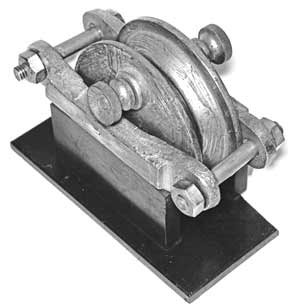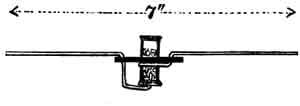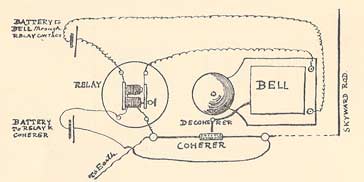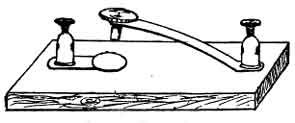Early Ham Radio Equipment: Pre 1914
The early ham radio equipment used prior to 1914 included spark gap transmitters, coherers, crystal sets and the like.
Ham Radio History Includes:
Ham radio history overview
Early foundations
First radio hams
Early ham radio equipment
Licenses introduced
Callsigns
National societies
First World War
Trans-Atlantic contacts
The very early ham radio equipment was very different to that which is used today.
The technologies that were used for the early ham radio equipment included spark gap transmitters, coherers, magnetic detectors and antennas that were very different to those used today.
Early ham radio transmitters
The transmitters used by these early radio amateurs were almost invariably spark gap transmitters.

The most common way of generating the high voltage required was to use an induction coil and a mechanism which broke the circuit periodically. Car ignition systems of the day were often put to good use to accomplish this as the components could be bought relatively easily. The high voltage from the coil was then connected across the spark gap. Typically a spark gap could be two brass spheres placed about half an inch apart. One of the major problems found when using spark gaps was the large amount of audible noise they generated. As a result many amateurs enclosed their spark gaps to reduce this.
With the spark generated the output was connected to the tuned circuit so that all the energy could be concentrated around a particular wavelength. In turn this was then connected to the aerial. Often the connection was made directly with no series capacitance in circuit with the result that the high voltage from the induction coil would appear directly on the aerial. Accordingly aerials had to be very well insulated and care had to be taken not to touch them.
The tuned circuits in the transmitters were grand affairs. The coils were often ten or more inches in diameter and often wound on beautifully finished formers. Tuning was again accomplished using taps on the coils but sometimes variable condensers were employed. In view of the high voltages which were used these condensers were large. They often employed meshed plates which could be moved in and out to vary the capacitance.
Early ham radio receivers
Since the introduction of the first licences there had been a number of major improvements in the technology which was used. Originally coherers were the only form of detector, but then in 1904 Ambrose Fleming invented the diode.

This was followed around 1906 in America by de Forest who invented the triode. However the most important advance for the amateur experimenter was the crystal detector. As valves were very expensive it gave a cheap and efficient method of detecting signals. A number of different types of these detectors were used. Early types used two crystals, but these gave way to more sensitive single crystal point contact detectors which were given the name "Cat's Whiskers".
Tuning in a receiver was generally accomplished using a variable inductor. Although capacitors (or condensers as they were called) could be used they were more difficult to make in a variable form.

Early ham radio antennas
In the early days of amateur radio and wire-less technology in general, many factors were very new and there was little understanding about the ways in which some items worked. Antennas, or as they were often called, aerials were no exception.
Often they were developed by trial and error. As the frequencies were low, they were often quite large.
Often antennas consisted of as much wire raised as high as possible. Others followed more standard designs.One design which gained popularity was called a "flat top" as it had a multi wire top. Another popular design consisted of a cage of about six wires separated by a hoop at each end.
Typical home made Morse key
In these very early days of amateur radio it was not possible to buy ready built parts. Everything had to be made from scratch.
One example of this was a' Morse tapping key' that was described in a book from the turn of the century called 'Wireless Telegraphy and Hertzian Waves' by S R Bottone.
This early item of amateur radio equipment was said to be "very convenient for the purpose of signalling and if the Morse system is used, it is more handy than a commutator."
"To make the instrument," Bottone described, "the following simple plan may be adopted. A piece of mahogany about 6inches long, 3 inches wide and half an inch thick is selected and after having been squared and smoothed up is fitted with a drawing pin at the centre of the narrower edge. This drawing pin is put into connection with a terminal by means of a brass strap about half an inch wide and about 1/32inche thick. At the other extremity of the board a hole is drilled for a second terminal, under the shoulder of which passes a rather stiff spring (a piece of crinoline steel about half an inch wide will do very well), of such a length to reach and cover, when pressed down, the head of the drawing pin."

or as it was called a 'tapping key' from 1900.
"A hole must be drilled at this extremity of the spring, exactly over the head of the drawing pin, and in this hole must be fitted a stout piece of brass rod, which can be sweated or screwed into the hole in the spring, and furnished above with a neat little knob of ebonite or boxwood."
Bottone goes on to describe how best to use the key with a transmitter.
 Written by Ian Poole .
Written by Ian Poole .
Experienced electronics engineer and author.
More History:
Radio history timeline
History of the radio
Ham radio history
Coherer
Crystal radio
Magnetic detector
Spark transmitter
Morse telegraph
Valve / tube history
PN junction diode invention
Transistor
Integrated circuit
Quartz crystals
Classic radios
Mobile telecoms history
Vintage mobile phones
Return to History menu . . .




